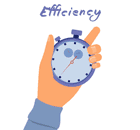8 Secrets to Improve Scrum Team Productivity
Scrum success is linked with collective team effort and effective collaboration. Therefore, Scrum team productivity is directly linked with project success. Boost your Scrum team's productivity by learning the key secrets to improve productivity.

In the current competitive landscape, organizations, especially software firms, are witnessing immense pressure to release new advanced software solutions at a faster pace. To cope with changing business dynamics, many software firms have adopted the Scrum framework for their software development processes. Scrum provides a flexible, iterative development approach that promotes collaboration, adaptability, and continuous feedback-based improvements.
Despite adopting Scrum, it is seen that the development team is often overworked or demotivated because of the continuous demand to "do more" without sufficient support or a clear understanding of how to improve their productivity within the Scrum framework. However, we know that Scrum is a powerful framework that can empower the development team to handle any workload efficiently if implemented correctly. Therefore, this article will explore all the core secrets that can improve the Scrum team's productivity and help them showcase the best performance regardless of the workload.
Factors Influencing Scrum Team Productivity
Scrum is a structured framework that involves specific roles, events, and principles that collectively lead to successful implementation. Therefore, many metrics can impact the success of Scrum, but the one main metric that influences its success significantly is "productivity".
Several factors in the Scrum framework can directly or indirectly influence the team's productivity. So, before we begin discussing how to improve Scrum team productivity, let's quickly shed light on some of the main factors that influence the team's productivity:
1. Team Working Culture
The team's composition and working culture can play a crucial role in influencing productivity. Individual skills, experience, communication, trust, and other factors define the work culture and directly impact the productivity of team members.
2. Workload
When the development team is forced to work on new tasks continuously, they not just get overburdened but also become unclear about where all these efforts will lead to. However, when the workload is manageable, and their efforts are appreciated, it leads to more focused work and productivity.
3. Unrealistic Expectations
Some organizations set unrealistic expectations for their Scrum team, mainly in terms of delivering a large volume of work within tight deadlines or expecting them to achieve unattainable goals. This puts pressure on team members, eventually impacting their productivity.
4. Lack of Resources
When the Scrum team faces a lack of resources, it can hinder their ability to showcase their full potential. Limited resources, whether it's limited team members, insufficient or outdated tools and infrastructure, or anything else, can significantly impact their productivity.
5. Time Management
Time management between project-related activities and other corporate responsibilities is also directly linked with Scrum's team productivity. It is because effective time management practices can optimize valuable work time and avoid excessive meetings.
6. Project Clarity
The Scrum team should have a clear vision of the project and its requirements. Every member should have a clear understanding of the project scope to avoid misunderstandings and delays.
7. Communication Environment
The communication within the team and with stakeholders should be clear and timely to prevent misunderstanding and ensure smooth collaboration. Any hurdles in communication can indirectly impact the productivity of the Scrum team.
In short, many factors can impact the Scrum team's productivity. However, most of the issues are easily fixable by the team by carefully evaluating the loopholes and addressing them gradually.
8 Secrets to Improve Scrum Team Productivity
The Scrum team is a foundation for successful project development, and improving their productivity is critical to achieving project success. Below are the eight ways to improve Scrum team productivity and unlock their full potential in delivering exceptional software solutions:
1. Grip the Fundamentals
It is a universal practice that when we try something for the first time, we intend to follow the standard instructions. The same concept applies to Scrum. Scrum fundamentals and core practices cover the essential building blocks of the framework that contribute to improved team productivity.
Whether it's roles/responsibilities, sprint planning, daily stand-ups, sprint review, sprint retrospective, or backlog refinement, understanding and implementing fundamental Scrum practices can establish a strong foundation for productivity. Therefore, the Scrum team should have a solid grip on Scrum fundamentals.
2. Improve Planning Phases
Efficient planning phases in Scrum are crucial for establishing project clarity and ensuring successful execution by the team. Therefore, Scrum teams should try to make their planning phases effective and rewarding.
At the start of the project, it is vital to hold a "Product Backlog Estimation Meeting", where the development team discusses product backlog items and estimates the efforts using any popular estimation technique, such as Planning Poker, Async Poker, Dot Voting, etc. This way, all members clearly understand what level of effort they have to input and the expected challenges along the way.
Next, they can easily pick the top priority items when they head for sprint planning because they know the backlog beforehand. This way, they can commit more to achieving sprint goals, leading to more productivity and quality outcomes.
After a few planning rounds, the team should evaluate its planning accuracy in terms of how the team managed to forecast and deliver the planned work. This evaluation helps the team identify areas of improvement and refine their planning process further.
3. Keep Meetings To-The-Point
Scrum emphasizes a lot on meetings and collaboration. It initiates the project with a sprint planning meeting, followed by daily stand-up meetings to ensure ongoing progress, and culminates in a sprint review and retrospective sessions. These meetings are essential for effective communication and collaboration within the Scrum framework. However, keeping the meetings focused and concise is crucial to optimize team productivity.
To ensure meetings are to-the-point, Scrum teams should set clear objectives for each meeting, stick to timeboxes, encourage active participation, minimize distractions, and summarize action items at the end of the meeting. In short, focused and to-the-point meetings keep team members engaged, improving their productivity and commitment to work.
4. Evaluate and Increase Cycle Time
Cycle time in Scrum is the duration for a product backlog item to move through the entire development process, from being picked during sprint planning to being considered completed. It is an excellent metric to determine the productivity of the team.
A productive team keeps its cycle time short and tries to make it as low as possible. So, break down the cycle time into smaller chunks, such as coding, testing, deployment, etc. With this, the team can identify bottlenecks and see where it takes the most time. Once done, the team can fix the issues and eventually improve its cycle time and productivity.
5. Be Transparent
It is important that all Scrum team members are aware of what is going on before, during, and after the end of the sprint. It is because transparency triggers accountability, and accountability urges the development team to be more productive. Besides that, transparency also helps to make team members dedicated to the project and overall company goals.
To ensure transparency, the teams should conduct regular daily stand-up meetings, visualize processes through the Kanban board, share metrics and progress, and maintain open and transparent communication channels. This way, when transparency is reflected in all stages of Scrum, the team can showcase more commitment and focus on achieving the project goals.
6. Deliver Functional Increments
Scrum emphasizes delivering functional increment in every sprint, no matter whether it is as small as adding a login feature in the product. This is because it makes sprint review meetings more effective, as stakeholders can show more engagement. They can test the new increment and engage more with the development team, leading to increased satisfaction.
This also positively impacts the Scrum team's productivity, as it allows the team to demonstrate progress and receive immediate feedback and appreciation, promoting a sense of accomplishment and motivation.
7. Acknowledge Teamwork, not Individual Performance
Scrum makes collaboration a central aspect of its framework. In fact, many attributes that the strength of Scrum lies in the collective effort the team makes to achieve the project goals. Therefore, it is important to recognize and emphasize the value of teamwork over individual performance.
Although individual contributions are vital, acknowledging teamwork is crucial to promoting a collaborative and high-performing Scrum team. For that, creating an environment that encourages teamwork, acknowledges and celebrates team efforts to achieve milestones, and rewards behaviors that promote collaboration within teams must be emphasized. This way, the team can develop a sense of shared purpose, motivation, and unity, which enhances trust and a positive work environment.
8. Implement Continuous Improvement Culture
The last tip to improve the Scrum team's productivity is to practice the culture of continuous improvement. Scrum requires training and experience to master, but it still needs regular improvement to adapt to evolving needs and challenges.
The continuous improvement culture can improve the productivity of the Scrum team as they get to address the bottlenecks. For this, the sprint retrospective meeting plays a critical role. When a team regularly conducts retrospective meetings at the end of each sprint, they get a chance to sit together and discuss their performance, processes, and outcomes. This eventually helps them identify areas for growth and then decide the actionable improvements they can adopt.
Wrapping Up
Scrum is tested to increase productivity by 3-4 times for teams and even up to 8 times for a few best Scrum teams. So, it is true that Scrum is linked with enhanced productivity, but it can turn the other way around if not implemented correctly. However, it is common to occasionally see a drop in the team's productivity, but what matters is how the team addresses and overcomes those challenges. By showing a strong commitment to Scrum principles and implementing proven strategies, as discussed above, teams can leverage the full potential of Scrum, drive productivity, and deliver high-quality products.



